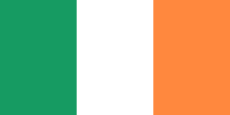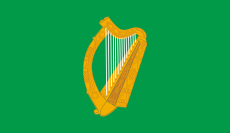Cross-border flag for Ireland facts for kids
The island of Ireland is a special place. It's divided into two main parts: the Republic of Ireland (an independent country) and Northern Ireland (which is part of the United Kingdom). Because of this, there isn't one single flag that everyone on the island agrees represents both areas.
This can be tricky for groups that operate across the whole island, like sports teams or churches. When these groups compete or meet internationally, they need a flag to represent them. Many different flags have been used or suggested over time.
Contents
Saint Patrick's Saltire: A Symbol for All Ireland?
The Saint Patrick's Saltire is a red 'X' shape on a white background. It became part of the Union Flag in 1801. This happened when Ireland joined with Great Britain to form the United Kingdom of Great Britain and Ireland.
Today, some people see the Tricolour (Ireland's official flag) as representing only the Republic of Ireland. They might suggest the Saint Patrick's Saltire as a neutral symbol for the whole island.
Who Uses the Saint Patrick's Saltire?
The Church of Ireland is a Protestant church on the island. They use this flag on their church grounds. This is similar to how Anglican churches in England, Scotland, and Wales use flags of their patron saints.
St. Patrick's College, Maynooth, a Catholic university, also flies this flag on graduation days. So, both major Christian churches on the island use it.
Other groups have used modified versions of this flag. These include the Irish Rugby Football Union in the past. The Royal College of Surgeons in Ireland and the Commissioners of Irish Lights still use it today.
The Irish Tricolour: A National Flag
The Irish tricolour has three vertical stripes: green, white, and orange. This is the official flag of the Republic of Ireland. Many Irish nationalists believe it represents the entire island.
For example, Gerry Adams, a well-known politician, said in 2011 that this flag represents "all Thirty-Two Counties" of Ireland.
However, not everyone agrees. People who support Ulster unionism (staying part of the UK) do not see it as a flag for the whole island. In 1951, a politician named James McSparran said the tricolour was the "national flag of Ireland." Other members quickly corrected him, saying it was only the flag of the Irish Republic.
Sports and the Tricolour
The Gaelic Athletic Association (GAA) is a sports organization that covers the whole island. They fly the tricolour at their matches, even when teams from Northern Ireland are playing. The Ireland international rules football team, which includes players from both parts of Ireland, also uses this flag.
The Golfing Union of Ireland also covers the whole island. Their teams compete under the tricolour in international golf events.
Four Provinces Flag: A United Symbol
The Four Provinces flag combines the symbols of Ireland's four traditional provinces: Ulster, Munster, Leinster, and Connacht. The way the symbols are arranged can sometimes change. This flag is often seen as a way to represent the entire island by showing all its parts.
Erne Flag: For Waterways
The Erne flag is green, white, and blue. It was first used on the Shannon–Erne Waterway. This waterway crosses the border between the Republic of Ireland and Northern Ireland. Instead of flying a national flag, boats on this waterway often use the Erne flag. The Inland Waterways Association of Ireland, an all-island group, supports its use.
Harp Flags: An Ancient Irish Symbol
The harp (or cláirseach) has been a symbol of Ireland for a very long time. It first appeared on Irish coins around 1534 during the time of Henry VIII. Over the centuries, the harp's design changed. Sometimes it looked like a "winged maiden." Later, the Maid of Erin was a symbol of Ireland as a woman holding a more realistic harp.
The harp on the modern coat of arms of the Republic of Ireland is based on the "Brian Boru" harp. This famous harp is kept at Trinity College, Dublin.
Blue Harp Flag
Since 1603, the Royal Standard of the United Kingdom has included a harp on a blue background to represent Ireland. The current design, from 1953, shows a golden harp with silver strings on a blue field. This shade of blue was known as Saint Patrick's Blue in the past.
Green Harp Flag
The color green became associated with the harp flag because of the United Irishmen. This was an Irish nationalist group in the 1700s. Green was a color of rebellion at that time.
This flag, with a gold harp on a green background, was common in the 1800s and early 1900s. It was linked to more moderate nationalist groups. Today, it looks the same as the modern Flag of Leinster.
Sporting Flags: Unique Team Symbols
Many sports organizations in Ireland cover the whole island. When their teams compete internationally, they often use a special flag for their organization. These flags usually include traditional.
- The Ireland cricket team uses a blue flag with shamrocks.
- The Ireland men's national field hockey team uses a flag with a shield showing the symbols of the four provinces.
- The Ireland rugby team's flag is green. It features the shields of the four provinces and the Irish Rugby Football Union's logo. When they play outside Ireland, only this flag is shown.
Flags at Rugby Matches
At rugby matches in Northern Ireland (like at Ravenhill Stadium), the Flag of Ulster (a yellow flag) is also displayed. This flag represents the nine-county province of Ulster, which includes counties in both Northern Ireland and the Republic. It's different from the Ulster Banner (a white flag), which was the former flag of the Northern Irish government.
At matches in the Republic of Ireland (like at Lansdowne Road), the Irish tricolour is flown along with the rugby team's flag and the Ulster flag.
Formula One and Flags
Eddie Irvine, a Formula One driver from Northern Ireland, once asked for a white flag with a shamrock if he finished in the top three. This was after a misunderstanding in 1997 when an Irish tricolour was used for him. The FIA (the racing authority) said the Union Flag had to be used, following their rules.
Show Jumping Flags
The Show Jumping Association of Ireland (SJAI), now called Showjumping Ireland, used a green flag with its crest when competing internationally after World War II. This crest was based on the four provinces.
Later, the SJAI joined with the Irish Army Equitation School for some competitions. For these events, they competed under the tricolour. However, the SJAI kept using its own flag for other competitions until the late 1970s.
Images for kids











